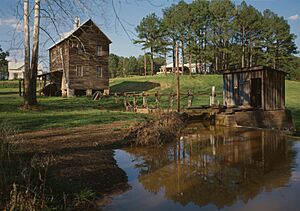Price's Mill facts for kids
Quick facts for kids |
|
|
Price's Mill
|
|

Price's Mill in 1987
|
|
| Location | E of Parksville on SC 33-138 at Steven's Creek, Parksville, South Carolina |
|---|---|
| Built | ca. 1890 |
| NRHP reference No. | 72001465 |
| Added to NRHP | November 22, 1972 |
Price's Mill is an old mill that used the power of water to grind grain. It is located near Parksville, South Carolina, on Stevens Creek. People also called it by other names like Calliham's Mill or Stone's Mill.
The mill building you see today was built around the 1890s. In 1972, Price's Mill was added to the National Register of Historic Places. At that time, it was one of the few mills left in South Carolina that still used water power.
Contents
History of Price's Mill
The story of Price's Mill began a long time ago. The first mill on Stevens Creek was started by David Calliham around 1768. He bought land in the area and set up a gristmill there. A gristmill is a place where grain, like corn, is ground into flour or meal.
Over the years, other buildings were also used for grinding grain or processing cotton near the mill. However, floods destroyed these other buildings.
How the Mill Operated
The current mill building was built in the 1890s. In 1910, a man named R. A. Price started running the mill. He worked very hard, sometimes seven days a week! He could produce a lot of cornmeal, up to 14,000 pounds (about 6,350 kg) every week.
When R. A. Price first started, farmers would bring their corn to the mill. He would grind it for them and keep a small part of the meal as his payment. This was called "toll milling."
R. A. Price continued to operate the mill until he passed away in 1968. His son, John M. Price, then took over the business. By this time, toll milling was no longer common. Instead, the mill would buy corn directly and then grind it into meal.
In the early 1970s, John M. Price would operate the mill three days a week. He produced about 7,000 pounds (about 3,175 kg) of cornmeal. He sold this cornmeal under the mill's own brand name in local stores. He even had one employee helping him.
Today, the mill is no longer used for grinding grain.
Architecture and How it Worked
Price's Mill is a two-story building made of wood. It has a pointed roof, called a gable roof. The building is made from rough pine wood. You can see large wooden beams, about 12 inches (30 cm) by 12 inches (30 cm), that are joined together using a special method called mortise and tenon, held with wooden pegs. The mill stands on a foundation of brick pillars.
The Grinding Stones
Inside the mill, there are large grinding stones. These stones are called burr-type millstones and are about 42 inches (107 cm) across. They are covered by a wooden box.
- The top stone, called the runner stone, spins around. It has a round hole in the middle.
- The bottom stone, called the bedstone, stays still. It has a square hole.
Grain is poured into a funnel, goes through the holes in the stones, and is ground between them. The ground meal then comes out into a bin. The mill operator could raise or lower the top stone to change how fine or coarse the meal would be.
Water Power System
The mill used water from Stevens Creek to power its machinery.
- Originally, there was a dam made of rocks and mortar built in the early 1800s to hold back the water.
- In 1913, this old dam was replaced with a new concrete dam, which was 13 feet (4 m) tall.
- The water from the dam flowed through a channel and turned a large steel turbine. A turbine is like a water wheel that spins very fast.
- The spinning turbine powered a long shaft, about 50 feet (15 m) long. This shaft connected to a wooden gear system located below the mill building. This system then transferred the power to the grinding stones inside the mill.




